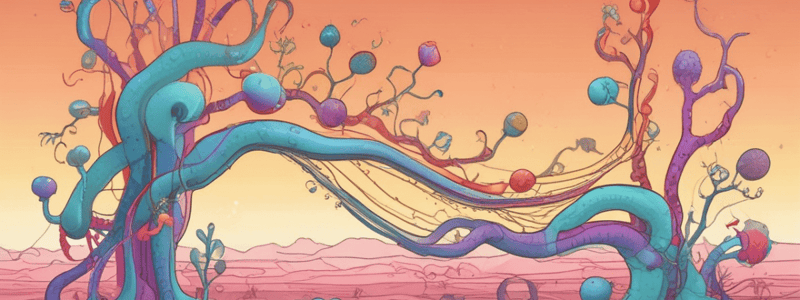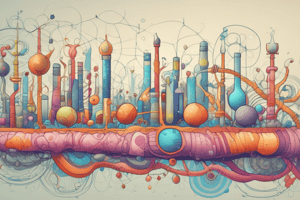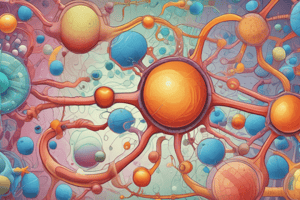Podcast
Questions and Answers
What is the primary function of the citric acid cycle in cellular respiration?
What is the primary function of the citric acid cycle in cellular respiration?
- To produce ATP and NADH and FADH2 (correct)
- To generate a proton gradient across the mitochondrial membrane
- To break down glucose into pyruvate
- To synthesize glucose from carbon dioxide and water
What is the net gain of ATP produced during the complete breakdown of one glucose molecule?
What is the net gain of ATP produced during the complete breakdown of one glucose molecule?
- 30 ATP molecules
- 36 ATP molecules
- 20 ATP molecules
- 38 ATP molecules (correct)
What is the role of oxygen in the electron transport chain?
What is the role of oxygen in the electron transport chain?
- To synthesize ATP from ADP and Pi
- To donate electrons to the electron transport chain
- To serve as the final electron acceptor (correct)
- To pump protons across the mitochondrial membrane
What is the name of the process by which ATP is produced during the electron transport chain?
What is the name of the process by which ATP is produced during the electron transport chain?
What is the end product of glycolysis?
What is the end product of glycolysis?
What is the purpose of the proton gradient established during the electron transport chain?
What is the purpose of the proton gradient established during the electron transport chain?
What is the primary difference between aerobic and anaerobic exercise?
What is the primary difference between aerobic and anaerobic exercise?
What is the byproduct of the breakdown of glucose during cellular respiration?
What is the byproduct of the breakdown of glucose during cellular respiration?
Which of the following statements about glycolysis is true?
Which of the following statements about glycolysis is true?
What is the primary function of the electron transport chain?
What is the primary function of the electron transport chain?
Which of the following is NOT a product of the Kreb's cycle?
Which of the following is NOT a product of the Kreb's cycle?
What is the energy yield of the electron transport chain?
What is the energy yield of the electron transport chain?
Which enzyme is involved in the conversion of glucose to pyruvate?
Which enzyme is involved in the conversion of glucose to pyruvate?
What is the location of the electron transport chain?
What is the location of the electron transport chain?
During the breakdown of glucose, what is the primary function of electron carriers?
During the breakdown of glucose, what is the primary function of electron carriers?
What is the primary fate of the energy released during the breakdown of glucose?
What is the primary fate of the energy released during the breakdown of glucose?
What is the role of substrate-level phosphorylation in the breakdown of glucose?
What is the role of substrate-level phosphorylation in the breakdown of glucose?
What is the outcome of the complete breakdown of one glucose molecule in the presence of oxygen?
What is the outcome of the complete breakdown of one glucose molecule in the presence of oxygen?
What is the primary mechanism by which ATP is generated during the breakdown of glucose?
What is the primary mechanism by which ATP is generated during the breakdown of glucose?
What is the net result of the electron transport chain during the breakdown of glucose?
What is the net result of the electron transport chain during the breakdown of glucose?
What is the relationship between catabolic reactions and the breakdown of glucose?
What is the relationship between catabolic reactions and the breakdown of glucose?
What is the primary function of the breakdown of glucose in cellular respiration?
What is the primary function of the breakdown of glucose in cellular respiration?
As electrons pass through the electron transport chain, what happens to their energy level?
As electrons pass through the electron transport chain, what happens to their energy level?
What is the primary function of electron carriers in cellular respiration?
What is the primary function of electron carriers in cellular respiration?
What is the result of the reactions in which NAD+ and FAD gain or lose electrons?
What is the result of the reactions in which NAD+ and FAD gain or lose electrons?
What is the term for reactions involving electron transfers?
What is the term for reactions involving electron transfers?
What happens to electron density on atoms in a redox reaction?
What happens to electron density on atoms in a redox reaction?
Why do electrons tend to be hogged by oxygen in a water molecule?
Why do electrons tend to be hogged by oxygen in a water molecule?
What is the role of the proton gradient in the electron transport chain?
What is the role of the proton gradient in the electron transport chain?
What is the name of the enzyme involved in the synthesis of ATP during the electron transport chain?
What is the name of the enzyme involved in the synthesis of ATP during the electron transport chain?
What is the process by which ATP is produced during the electron transport chain?
What is the process by which ATP is produced during the electron transport chain?
What is the result of the breakdown of glucose in cellular respiration?
What is the result of the breakdown of glucose in cellular respiration?
In the context of biology, what can be used as a proxy for the transfer of electrons during redox reactions?
In the context of biology, what can be used as a proxy for the transfer of electrons during redox reactions?
Which atom is more electronegative than any of the other major atoms found commonly in biological molecules?
Which atom is more electronegative than any of the other major atoms found commonly in biological molecules?
What is the energy state of electrons when associated with less electronegative atoms, such as carbon or hydrogen?
What is the energy state of electrons when associated with less electronegative atoms, such as carbon or hydrogen?
What is the purpose of the electron transport chain in cellular respiration?
What is the purpose of the electron transport chain in cellular respiration?
What is the result of the energy released in electron transfers in the electron transport chain?
What is the result of the energy released in electron transfers in the electron transport chain?
Why does the trick of using gain or loss of oxygen and hydrogen atoms as a proxy for electron transfer work?
Why does the trick of using gain or loss of oxygen and hydrogen atoms as a proxy for electron transfer work?
What is the energy state of electrons when associated with a more electronegative atom, such as oxygen?
What is the energy state of electrons when associated with a more electronegative atom, such as oxygen?
What is the role of the electron transport chain in generating ATP?
What is the role of the electron transport chain in generating ATP?
What happens to the energy released as electrons move to a lower-energy state in the electron transport chain?
What happens to the energy released as electrons move to a lower-energy state in the electron transport chain?
Why does cellular respiration involve a series of redox reactions?
Why does cellular respiration involve a series of redox reactions?
Flashcards are hidden until you start studying
Study Notes
Cellular Respiration
- Cellular respiration is the process of extracting energy from the food we eat, specifically glucose, and converting it into ATP (adenosine triphosphate), the energy currency of the cell.
- Glucose is broken down into carbon dioxide and water, releasing energy that is used to produce ATP.
Breakdown of Glucose
- Glucose is broken down into two pyruvate molecules through glycolysis, the first stage of cellular respiration.
- Each pyruvate molecule is then converted into acetyl-CoA, which enters the citric acid cycle (also known as the Krebs cycle or tricarboxylic acid cycle).
- The citric acid cycle produces more ATP, as well as NADH and FADH2, which are used in the electron transport chain to generate even more ATP.
Electron Transport Chain
- The electron transport chain is a series of protein complexes located in the mitochondrial inner membrane that use the energy from NADH and FADH2 to pump protons across the membrane.
- This creates a proton gradient, or concentration gradient, across the membrane.
- The energy from the proton gradient is used to drive the production of ATP through the process of chemiosmosis.
ATP Yield
- The complete breakdown of one glucose molecule yields 38 ATP molecules.
- This is the net gain of ATP produced during cellular respiration, which is the sum of the ATP produced during glycolysis, the citric acid cycle, and the electron transport chain.
Importance of Oxygen
- Oxygen is required for the electron transport chain to function, as it serves as the final electron acceptor.
- Without oxygen, the electron transport chain cannot function, and ATP production is severely impaired.
- This is why aerobic exercise, which requires oxygen, is more efficient for energy production than anaerobic exercise, which does not require oxygen.
Anaerobic Respiration
- In the absence of oxygen, cells can still produce energy through anaerobic respiration.
- Anaerobic respiration produces lactic acid, which can be used by the cell for energy or excreted.
- Anaerobic respiration is less efficient than aerobic respiration, producing only 2 ATP per glucose molecule compared to 38 ATP per glucose molecule in aerobic respiration.
Conclusion
- Cellular respiration is the process of extracting energy from glucose and converting it into ATP.
- The three stages of cellular respiration are glycolysis, the citric acid cycle, and the electron transport chain.
- Oxygen is required for the electron transport chain to function, and anaerobic respiration produces less ATP than aerobic respiration.
Cellular Respiration
- Cellular respiration is the process of converting glucose into ATP (adenosine triphosphate), the energy currency of the cell.
- Glucose is broken down into carbon dioxide and water, releasing energy used to produce ATP.
Breakdown of Glucose
- Glucose is broken down into two pyruvate molecules through glycolysis, the first stage of cellular respiration.
- Each pyruvate molecule is converted into acetyl-CoA, which enters the citric acid cycle.
- The citric acid cycle produces ATP, NADH, and FADH2, which are used in the electron transport chain.
Electron Transport Chain
- The electron transport chain is a series of protein complexes in the mitochondrial inner membrane.
- It uses energy from NADH and FADH2 to pump protons across the membrane, creating a proton gradient.
- The energy from the proton gradient drives ATP production through chemiosmosis.
ATP Yield
- The complete breakdown of one glucose molecule yields 38 ATP molecules.
- This is the net gain of ATP produced during cellular respiration.
Importance of Oxygen
- Oxygen is required for the electron transport chain to function as the final electron acceptor.
- Without oxygen, the electron transport chain cannot function, and ATP production is severely impaired.
Anaerobic Respiration
- In the absence of oxygen, cells produce energy through anaerobic respiration.
- Anaerobic respiration produces lactic acid, which can be used for energy or excreted.
- Anaerobic respiration is less efficient, producing only 2 ATP per glucose molecule.
Cellular Respiration
Glycolysis
- Occurs in the cytoplasm and is the first stage of cellular respiration
- Breaks down glucose (a 6-carbon sugar) into pyruvate (a 3-carbon molecule)
- Produces 2 ATP, 2 NADH, and 2 pyruvate molecules, with an energy investment of 2 ATP
- Involves enzymes such as hexokinase, phosphoglucose isomerase, aldolase, and triosephosphate isomerase
Kreb's Cycle (Citric Acid Cycle)
- Takes place in the mitochondrial matrix and is the second stage of cellular respiration
- Breaks down pyruvate into Acetyl-CoA, which then enters the Kreb's cycle
- Produces 2 ATP, 6 NADH, 2 FADH2, and CO2, with an energy yield of 2 ATP, 6 NADH, and 2 FADH2
- Involves enzymes such as citrate synthase, aconitase, and isocitrate dehydrogenase
Electron Transport Chain
- Occurs in the mitochondrial inner membrane and is the third and final stage of cellular respiration
- Transfers electrons from high-energy molecules (NADH and FADH2) to oxygen
- Produces most of the ATP generated in cellular respiration, with an energy yield of 32-34 ATP
- Involves electron transport chain complexes (I-IV), proton pumping and gradient formation, and ATP synthase and chemiosmosis
Cellular Respiration
- Cellular respiration is the process by which cells break down fuels like glucose to extract energy
- This process involves catabolic reactions, which break down larger molecules into smaller pieces
- Glucose, a 6-carbon molecule, is broken down into 6 carbon dioxide molecules and 6 water molecules, releasing energy in the process
Catabolic Reactions
- Energy contained in the bonds of glucose is released in small bursts, some of which is captured as ATP (adenosine triphosphate)
- ATP is a small molecule that powers reactions in the cell
- Much of the energy from glucose is dissipated as heat, but enough is captured to keep the metabolism of the cell running
ATP Synthesis
- There are two ways ATP is synthesized:
- Substrate-level phosphorylation: a phosphate group is transferred from a pathway intermediate to ADP (adenosine diphosphate), producing ATP
- Oxidative phosphorylation: electrons from glucose are transferred to electron carriers, then to the electron transport chain, and ultimately to oxygen, forming water
- This process releases energy, which is used to pump protons out of the matrix of the mitochondrion, forming an electrochemical gradient
- Protons flow back down their gradient through ATP synthase, driving the synthesis of ATP
Electron Carriers
- Electron carriers, also called electron shuttles, are small organic molecules that play key roles in cellular respiration
- They pick up electrons from one molecule and drop them off with another
- Two important electron carriers are NAD+ (nicotinamide adenine dinucleotide) and FAD (flavin adenine dinucleotide)
Redox Reactions
- Redox reactions involve the transfer of electrons from one molecule to another
- In a redox reaction, one molecule loses electrons (oxidized) and another molecule gains electrons (reduced)
- Redox reactions can be thought of as a change in electron density, rather than a full gain or loss of electrons
- In biology, oxidation and reduction can often be determined by the gain or loss of H or O atoms
- If a carbon-containing molecule gains H atoms or loses O atoms, it's likely been reduced (gained electrons or electron density)
- If a carbon-containing molecule loses H atoms or gains O atoms, it's probably been oxidized (lost electrons or electron density)
Importance of Redox Reactions
- Redox reactions allow the cell to extract energy from glucose
- Electrons from glucose are transferred to electron carriers, then to the electron transport chain, and ultimately to oxygen, forming water
- Energy is released as electrons move to a lower-energy state, and this energy is captured as a proton gradient and used to synthesize ATP
Studying That Suits You
Use AI to generate personalized quizzes and flashcards to suit your learning preferences.




